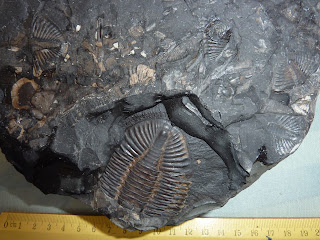Homo sapiens: Know Thy Self and What's
In A Name?
An Amateur Paleontologist
I suppose I am a bit of an amateur paleontologist, now that I mentioned about my small collection of trilobite fossils (in my last e-article). Paleontology is of course the study of life forms existing in prehistoric or geological times as found in the fossils of animals, plants and other organisms.
Biological Classification
A taxon is an organism.
In taxonomy, all biological organisms on Earth, both living or extinct, are defined scientifically into ranks or groups on the basis of common characteristics and are given specific names for identification and study. In the hierarchy of biological classification, there are eight major “taxonomic ranks”.
In the special case of modern humans or Homo sapiens (a subject on which we should all take an interest), the taxonomic ranks in question are listed in descending order as follows:
Domain: ... ,
Kingdom: ... ,
Phylum/Division: ... ,
Class: ...,
Order: Primates,
Family: Hominidae
Genus: Homo,
Species: Homo sapiens.
What is A “Species”?
A group of animals, or plants, with identical features and a similar mode of life constitutes a distinct population called a “species”. A species is a population of individuals capable of interbreeding to produce similar-looking offspring. Species showing close similarities are grouped into a genus, similar genera into a family, similar families into an order, similar orders into a class, and so on.
What does “Homo sapiens” mean?
For identification purposes, each species is given a two-word Latin name. Take for example, Homo sapiens again.
The first word “Homo” – a noun – is the name of the genus. The generic term “Homo”, meaning “man” (can be male or female), can be used for naming more than one species.
The second word “sapiens” – an adjective – meaning “wise”, may be referred to loosely as the name of the species.
The combination of both the generic name and the specific name (the so-called binominal naming system) identifies a unique species. The human species called “Homo sapiens” refers specifically to the “modern humans”; in Latin the two-word term means “wise man”.
Basic anatomical features of female and male humans. (These models have had body hair and male facial hair removed and head hair trimmed.)
Why Homo sapiens is A “Wise Man”?
The modern human does have the largest brain among the several species grouped under the genus Homo in the order of Primates. The modern human, Homo sapiens, is the only surviving species that is up-right walking, culture-sharing and possesses effective language and learning skills, etc.
The other four species that were extinct in the genus Homo are:
Homo habilis: evolved circa 2.8 million yrs. ago, use of stone tools. Brains about size of those of chimpanzees.
H. erectus: cranial size had doubled, first of the hominina to leave Africa from ca. 500,000 yrs. ago, evolving into H. antecessor, H. heidelbergensis and H. neanderthalensis.
H. heidelbergensis
H. neanderthalensis (Neanderthals)
It is considered that the modern humans likely first evolved in Africa about 200,000 years ago. They were social animals, they learned how to communicate, make tools and fire, cook foods and clothe themselves. In search of games and a safe and better environment, they gradually spread in small groups as hunter-gatherers in several waves of migration to other parts of the world – first throughout Africa, then Eurasia, Asia, Europe and the Americas. It is thought that Homo sapiens at some point in time interbred with neanderthals before the latter species had died off.
What Does the Future Hold for Homo sapiens?
With the almost continuous regional conflicts and wars, natural disasters, global warming and its attendant challenges, the probability of nuclear annihilation, impact by giant meteorite and so on, Stephen Hawking has pointed out that interplanetary travel and colonisation would ensure the continuation of the human species.Short orbital flights on a commercial scale will be offered shortly. Astronauts from a handful of technologically advanced countries have been working, experimenting, researching and living for some yeas on board the International Space Station, gathering vital data for prolonged space travel. China has concrete plans to build her own space station and launch lunar explorations. The U.S.A. has also announced her intention to construct a permanent base on the Moon. Homo sapiens travelling to Mars will be a reality in the near future...
From star dust and a single cell organism, we have indeed come quite a long way. We still have a long, long way to go, if we humans – who are highly intelligent and innovative and still evolving – do not, directly or indirectly, kill off ourselves first on this tiny, fragile blue planet called Earth.
Please handle with love ad care.











